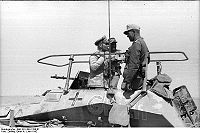- Operation Sonnenblume
-
Invasion of Egypt – Compass – Bardia – Kufra – Sonnenblume – Bardia raid – Tobruk – Brevity – Skorpion – Battleaxe – Flipper – Crusader – Gazala – (Bir Hakeim) – 1st Alamein – Alam Halfa – Agreement – 2nd Alamein – El Agheila
Operation Sonnenblume ("Sunflower") was the deployment of German troops (the Afrika Korps) to North Africa in February 1941, during the Second World War. These troops reinforced the remaining Italian forces in Libya after the Italian 10th Army was destroyed by British attacks during Operation Compass.
The order for the operation was issued by Oberkommando der Wehrmacht (OKW; Supreme Command of the Armed Forces) to Oberkommando des Heeres (OKH; Army High Command) and Oberkommando der Luftwaffe (OKL; Air Force High Command) on 6 February 1941. Two days later, the first units departed Naples for Africa and arrived on 11 February. On 14 February, the first units of the 5th Light Division (later renamed 21st Panzer Division) arrived in Tripoli, Libya. These units were the 3rd Reconnaissance Battalion and Tankhunter Unit 39; they were sent immediately to the front line at Sirte.
During the following months, more 5th Light Division units arrived, and in May the 15. Panzerdivision was embarked for North Africa.
Contents
5th Light Division
The 5. leichte-Division's (mot) (5th Light Division) tank regiment—5. Panzer-Regiment—arrived in North Africa aboard two convoys between 8 and 10 March 1941.[1] The regiment—155 tanks strong—consisted of 25 Panzer Is, 45 Panzer IIs, 61 Panzer IIIs, 17 Panzer IVs, three kleine Panzerbefehlswagens and four Panzerbefehlswagens.[2]
While the tanks of the regiment were being loaded onto Italian cargo ships in the port of Naples, the cargo ship Leverkusen caught fire and sank, resulting in the loss of the 10 Panzer IIIs and three Panzer IVs on board. Ten replacement Panzer IIIs—a mixture of Ausf F and G models—were requisitioned from 6. Panzer-Regiment, and three newly-built Panzer IV Ausf Es were shipped to Libya[2] between 10 and 14 April.[3] However, they did not reach the regiment until 29 April.[2]
A further 25 Panzer I Ausf A were shipped over to North Africa to reinforce the regiment arriving in Tripoli on 10 May.[2]
The on paper peak strength of the 5th Light Division in North Africa was therefore:
- 50 Panzer Is
- 45 Panzer IIs
- 71 Panzer IIIs
- 20 Panzer IVs
- 3 kleine Panzerbefehlswagens
- 4 Panzerbefehlswagens
All the tanks in 5. Panzer-Regiment were still painted dark grey (RAL 7021 dunkelgrau) and carried the 3. Panzerdivision's divisional emblem (inverted Y with two strikes)[4]
15. Panzerdivision
8. Panzer-Regiment was previously subordinate to the 10. Panzerdivision before being reassigned on 18 January to the newly-created 15. Panzerdivision, itself created from the 33. Infanteriedivision.[2]
8. Panzer-Regiment was shipped across to North Africa in three convoys between 25 April and 6 May 1941. The regiment—146 tanks strong—consisted of 45 Panzer IIs, 71 Panzer IIIs, 20 Panzer IVs, four kleine Panzerbefehlswagens and six Panzerbefehlswagens. By 28 May, the entire regiment had assembled at the front.[5]
Tank modifications
Following the fighting which had taken place in 1939-1940, the Heer was in the process of increasing the armour thickness on all of its tank designs thus factories were producing tanks with increased armour thickness. However, for those tanks already in service, field modifications were made where armoured plates were bolted onto the tanks to bring them up to the new specifications.
The majority, but not all, of tanks from the 5. and 8. Panzer-Regiments shipped across to North Africa during Operation Sonnenblume had received these field modifications and a small number were from the new factory production run.[6]
All tanks which were sent to North Africa were also modified for the tropical conditions, this included improving the engine air cooling circulation, the speed of the radiator fan increased and holes cut into hatch covers on the rear decks on the tanks.[6]
See also
Footnotes
References
- Jentz, Thomas L. (1998). Tank Combat In North Africa: The Opening Rounds, Operations Sonnenblume, Brevity, Skorpion and Battleaxe, February 1941 - June 1941. Schiffer Publishing Ltd. ISBN 0-76430-226-4.
- Playfair, Major-General I.S.O.; with Flynn R.N., Captain F.C.; Molony, Brigadier C.J.C. & Toomer, Air Vice-Marshal S.E. (2004) [1st. pub. HMSO 1956]. Butler, J.R.M. ed. The Mediterranean and Middle East, Volume II The Germans come to the help of their Ally (1941). History of the Second World War, United Kingdom Military Series. Naval & Military Press. ISBN 1-84574-066-1.
- Rommel, Erwin; with Basil Liddell-Hart (1982) [1953]. The Rommel Papers. New York: Da Capo Press. ISBN 0-30680-157-4.
Categories:
Wikimedia Foundation. 2010.

